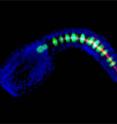Events coordination during embryogenesis
A new study by Weill Cornell Medical College scientists reveals a mechanism through which the expression of genes is controlled -- a finding that highlights genetic mutations that can impair the timing of gene expression. Such mutations can affect the co-ordination of key events that are required for stepwise development of an organism, and can also give rise to cancer by turning on genes at the wrong time. The study, published October 29 in the open access journal PLOS Biology, analyzes how the timing of gene expression is regulated in the notochord, the evolutionary and developmental precursor of the backbone. The notochord is the main feature that sets humans, mice, sea squirts and related animals (collectively known as chordates) apart from flies, worms and mollusks, and is essential for their development.
A crucial player in the development of the notochord is the Brachyury gene, which encodes a DNA-binding protein that switches on the expression of numerous notochord genes and ensures their sequential deployment during the formation of this pivotal structure. It was known that Brachyury directly binds distinct DNA sequences -- known as cis-regulatory modules (CRMs) -- that when bound act as molecular switches and control when and where these target notochord genes are expressed. What is addressed by this new study is how these switches could be flipped on by Brachyury at different times.
To clarify this point, scientists in the laboratories of Dr. Anna Di Gregorio and Dr. Yutaka Nibu, both in the Department of Cell and Developmental Biology, systematically analyzed the structure and activity of several notochord CRMs. The model they proposed suggests that some mutations don't appear to affect the ability of a CRM to be bound and activated but do affect the timing of expression of the gene containing the CRM. They found that in the sea squirt, timing of Brachyury switches depends on numbers: For genes that need to be turned on early in development, Brachyury binds the CRMs at multiple binding sites. However, genes that are expressed later in notochord development are controlled by Brachyury through single binding sites, while the notochord genes with the latest onsets are controlled by Brachyury indirectly, through a relay mechanism that involves other transcription factors. The paper shows an example of the effects of a mutation in the CRM that controls notochord expression of a laminin gene. In sea squirts as well as in humans, laminins are major components of the basement membranes and extracellular matrix that hold cells together within tissues, and are key regulators of cell migration, cell adhesion and cell proliferation. The Ciona laminin notochord CRM, which was identified in the Di Gregorio lab, requires two cooperative binding sites for Brachyury. When either one of these sites is mutated, Brachyury is unable to bind to that site, but can still bind to the remaining one.
"As a consequence, the CRM is still active in the notochord, but the full onset of its activity is delayed by a few hours, which is a crucial interval during the development of an organism," says Dr. Yutaka Nibu, adjunct assistant research professor and co-senior author of the study. "Such delay could cause a birth defect by slowing down the synthesis of a building block necessary for the organism to form properly, or might postpone the activation of a tumor suppressor gene and trigger cancer formation."
"Imagine that the gene is the light in a specific room of your house, and that the room is a specific cell in your body," adds Dr. Di Gregorio, an associate professor. "To turn the light on, you need to flip the light switch -- the CRM. A mutation that inactivates your switch would keep your room in the dark. However, a mutation that delays the onset of activity of your switch would still let you turn on the light, but only at a later time. If you had to perform any task in that room that required a certain level of light, you would have to wait for a few hours until the light came on. During those precious hours, you would not be able to complete your tasks in that room, or you could have a burglar taking advantage of the darkness to wreak havoc in there."
In humans, mutations in the Brachyury gene have been associated with spina bifida, vertebral malformations, and chordoma, a rare but insidious cancer. "The work calls attention to a mostly unexplored area of gene regulation, and suggests that elusive mutations in CRMs, particularly those that alter the timing of gene expression, might explain the molecular origins of birth defects and diseases that have not been previously linked to mutations in protein-coding regions," says Dr. Di Gregorio.
Source: Weill Cornell Medical College
Articles on the same topic
- Events coordination during embryogenesisWed, 30 Oct 2013, 19:39:01 UTC
Other sources
- Events coordination during embryogenesisfrom Science DailyWed, 30 Oct 2013, 19:30:42 UTC
- Events coordination during embryogenesisfrom Biology News NetTue, 29 Oct 2013, 23:30:17 UTC
- Events coordination during embryogenesisfrom PhysorgTue, 29 Oct 2013, 21:00:34 UTC
